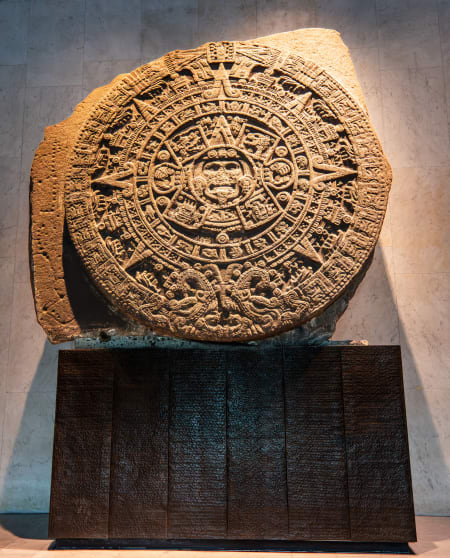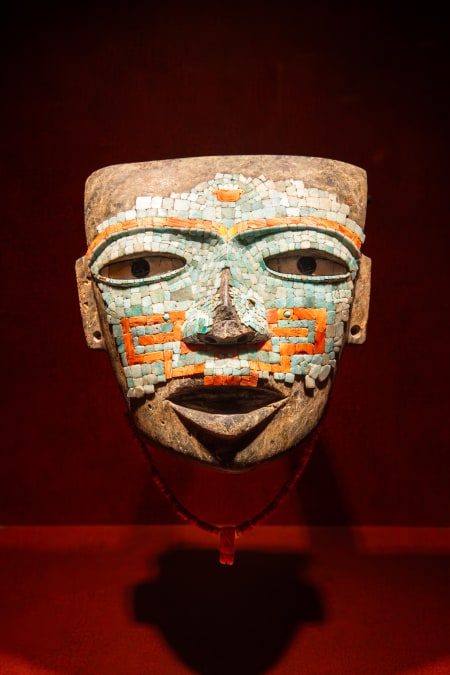The Story of Pre-Columbian Mexico
Mexico’s largest and most visited museum tells the story of the rise and fall of the great civilizations that inhabited this region of the Americas before the Spanish conquest. It provides a comprehensive history of these lands, broken down chronologically and geographically.
The story begins with the arrival of first humans over 30,000 years ago, before focusing on the Central Highlands region that surrounds present-day Mexico City. Here, powerful dynasties including Teotihuacán, the Toltecs and the Aztecs (Mexica) built great political and economic power bases over the centuries.
The collection then covers other regions of Mexico in geographic order. The great civilizations of the Maya, Olmecs and Zapotecs are on display, along with the indigenous groups of more remote regions in the north and west.
Finally, the upper floor of the museum explores the lives of Mexico’s indigenous peoples after the Spanish conquest, providing an insight into the communities that live across the country to this day.

A Remarkable Archaeological Collection
Some of the most impressive pre-Columbian sculptures uncovered anywhere in the Americas are on display in this museum.
The collection dedicated to the Aztecs (Mexica) is perhaps the most outstanding. The Sun Stone is emblematic of Aztec culture and artistry. This 12-foot wide carving is covered in iconography and symbols of Aztec cosmology. There is also a giant sacrificial stone, the Stone of Tízoc, and an intricately carved sculpture of the god Coatlicue, as well as many smaller pieces of art devoted to the Aztec gods.
The collections dedicated to the earlier civilizations that ruled the Central Highlands are equally impressive. The Toltec exhibit features an iconic Atlante sculpture, a dramatic 15-foot tall statue of a warrior. There are also masks and obsidian carvings recovered from the ruins of Teotihuacán.
From Mexico’s regions, the Olmec artifacts from the Gulf Coast are remarkable for their age, with giant sculptures and jade carvings that are around 3,000 years old. The Maya culture is fascinating, particularly the life-size recreation of the tomb of Pakal the Great. And Oaxaca’s Mixtec codices convey the richness of indigenous Mexico’s history, art, and mythology.

Tickets & Opening Hours
| Monday: | Closed | ||
|---|---|---|---|
| Tuesday to Sunday: | 09:00 AM | — |
06:00 PM |
| Tickets (Mexican Pesos): | $ 90 |
|---|---|
| Approx. cost in US dollars: | $ 5.00 |
Pass through the security check at the front doors of the museum. If you have any bags, you will have to leave these at the entrance. After passing through the security check, turn left, and the baggage deposit area is on your left, to the right of the gift shop.
Tickets can be purchased from the desks on the opposite side of the entrance hallway. Turn right after passing through the security checkpoint.
Tickets can be purchased online from:
Instituto Nacional de Antropología e Historia (INAH)
Select ‘Anthropology National Museum’ or ‘Museo Nacional de Antropología’ depending on whether you are browsing the English or Spanish version of the site.

Getting There
Situated directly opposite the gates to Chapultepec Park, the National Museum of Anthropology is within easy walking distance of some of Mexico City’s most popular sights.
A visit to the museum is best combined with a walking tour of Chapultepec Park, where you can visit Chapultepec Castle, Chapultepec Zoo, a botanical garden, and the nearby Museum of Modern Art.
The museum is around a 20-minute walk from the center of Polanco. It is a similar distance from the hotels and monuments of Avenida Paseo de la Reforma. The streets of Roma & Condesa are further away, around a 45-minute to 1-hour walk from the museum.
The National Museum of Anthropology can be safely reached on bicycle. There is a dedicated bike lane separated from the traffic which runs along Avenida Paseo de la Reforma.
Heading east, this bike lane passes the hotels and monuments around the Angel of Independence, continuing towards Palacio de Bellas Artes in the Centro Historico. Heading west, you can ride further into Polanco.
Every Sunday morning, Avenida Paseo de la Reforma is closed to traffic, which makes this the perfect time to tour this area on bicycle.
Bikes can be hired by the minute using the Ecobici app, with hundreds of stations located on almost every major street corner in this region of Mexico City. Download the app, find an Ecobici station, and unlock any bike by scanning the QR code printed on each bike.
Rideshare apps Uber and Didi are widely used across Mexico City.
Select as your destination:
- Museo Nacional de Anthropología
- Av. Paseo de la Reforma s/n, Polanco, Bosque Chapultepec I Sección, Miguel Hidalgo, 11580, Mexico City
The center of Mexico City is clogged with traffic and difficult for visitors to navigate when driving. But for those choosing to self-drive, there is a large parking lot located behind the National Museum of Anthropology.
Turibus is a convenient way to tour all of Mexico City’s major sights in a short time. Open-top buses offer great views of the city, while the driver takes care of navigating the chaotic streets.
The Turibus Centro Historico route runs down Avenida Paseo de la Reforma., where is passes Chapultepec Park. Here, the bus makes a stop right outside the Anthropology Museum.
This circuit covers many of the city’s other major points of interest, including:
- The Zócalo & Metropolitan Cathedral
- Palacio de Bellas Artes
- The Angel of Independence & Avenida Paseo de la Reforma
- Monument to the Revolution
Full details of the route and pick-up points are available from Turibus.
Tickets can be purchased in-person at the bus stops, or prebook online from Turibus, Viator or Get Your Guide
The National Museum of Anthropology is easily accessed along Line 7 of the Metrobus network, which runs along Avenida Paseo de la Reforma.
The nearest station is Antropología, which is located immediately outside of the museum.
To the east, this line heads past the hotels and monuments of Avenida Paseo de la Reforma, which is a short walk from the Roma and Condesa neighborhoods. It continues towards the station Hidalgo, which is a short walk from the sights of the Centro Histórico.
To the west, the route continues for a short distance to Auditorio and Campo Marte, which are conveniently located near the heart of Polanco.
The nearest Metro station is Auditoria on Line 7, which is one stop away from the center of Polanco.
To travel by public transport from the major touristic centers in Roma, Condesa & Polanco, the Metrobus provides more direct connections than the Metro.


